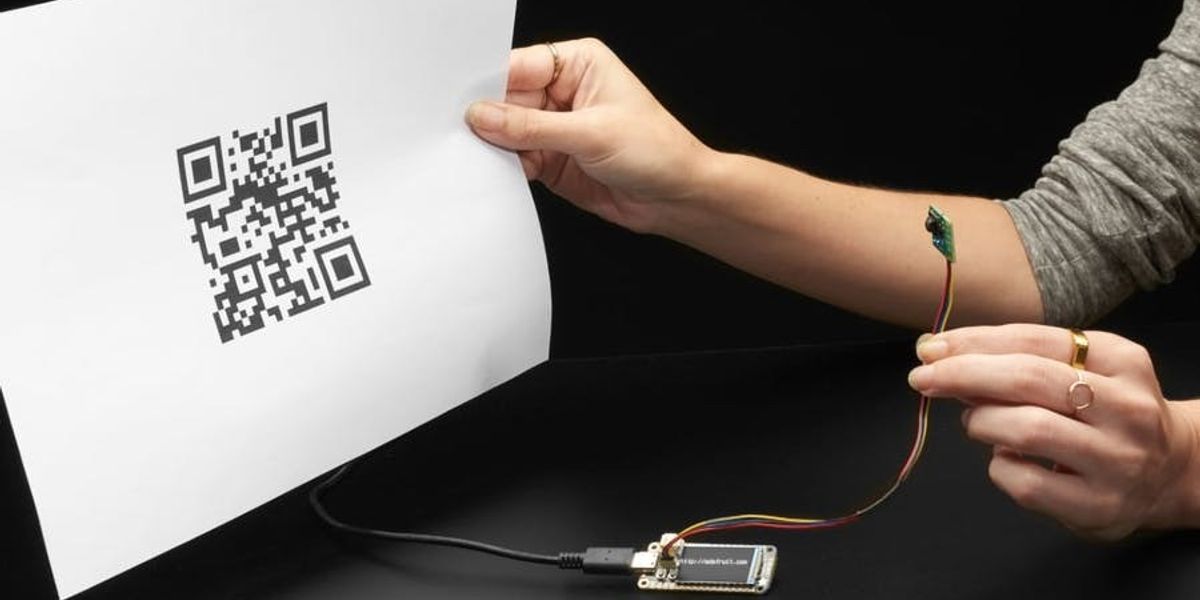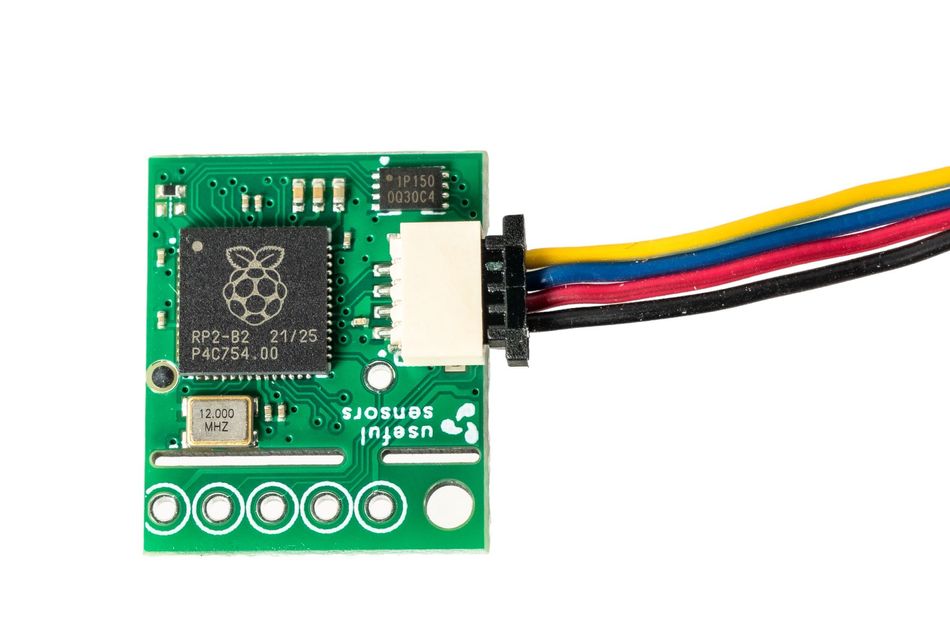Unlocking Efficiency: The AI-Powered Tiny Code Reader by Useful Sensors

Image credit: Gareth Halfacree
Discover how the AI-powered Tiny Code Reader by Useful Sensors revolutionises data input and verification tasks, offering unparalleled efficiency and accuracy. Explore the benefits for businesses and developers in integrating this cutting-edge technology into their operations.
In today's fast-paced world, the demand for efficient, automated data input and verification systems is more pressing than ever across various sectors. From retail and logistics to healthcare and manufacturing, the ability to quickly and accurately process information can significantly enhance operational efficiency, reduce errors, and improve customer satisfaction. This growing need has spurred innovation in data capture technologies, highlighting the importance of reliability, speed, and adaptability in diverse environments.
Enter the Tiny Code Reader by Useful Sensors, a cutting-edge solution at the intersection of convenience and technology. This device epitomises the advancements in artificial intelligence (AI), offering an innovative approach to reading QR codes and other data matrices. With its AI-powered capabilities, the Tiny Code Reader is designed to streamline the data capture and verification process, providing a seamless, effortless experience. Whether tracking inventory in a warehouse, authenticating tickets at an event, or facilitating contactless payments, this compact yet powerful tool can handle a wide range of applications with unprecedented ease and accuracy.
What sets the Useful Sensors Tiny Code Reader apart is its size and its sophisticated integration of AI algorithms. These algorithms enable the device to quickly identify and interpret QR codes, even under less-than-ideal conditions, such as poor lighting or awkward angles. This level of efficiency and adaptability ensures that businesses and organisations can maintain high productivity levels and offer enhanced customer services, reinforcing the critical role of smart, AI-driven tools in the digital age.
As we delve deeper into the capabilities and potential applications of the Tiny Code Reader, it's clear that this innovation is more than just a tool for reading codes—it's a gateway to a more efficient, connected, and technologically advanced future.
The Power of AI in Simplifying Data Input
AI You Can Trust
The AI technology behind the Tiny Code Reader is designed for reliability and accuracy, allowing users to read QR codes swiftly and precisely. Such technology promises private and secure AI applications encapsulated in solutions like AI in a Box, highlighting Useful Sensors' commitment to delivering non-intrusive, efficient AI tools. These efforts align with the broader industry trends of making AI more accessible and trustworthy for various applications, ensuring the data input process through QR code reading is fast and error-free.
Built-in Camera and AI Integration
The Tiny Code Reader ingeniously merges camera capabilities with AI technologies, eliminating the necessity for additional cameras or complex setup procedures. This integration is part of a trend where companies like Useful Sensors aim to embed AI tools into small, self-contained modules, focusing on privacy and offline functionality. By combining AI with camera technology directly on the device, the Tiny Code Reader can effortlessly interpret QR codes, streamlining the data input process without compromising on user privacy or requiring external hardware support.

Versatile Applications Across Industries
With its capacity to streamline operations across various sectors, the AI-powered Tiny Code Reader demonstrates a wide array of applications in enhancing efficiency and productivity, particularly in equipment setup, stock control in logistics and retail, and manufacturing processes.
In manufacturing, AI technologies like the one powering the Tiny Code Reader play a crucial role in automating and optimising production processes. For instance, AI can automate complex tasks, significantly reducing labour costs and improving productivity. This includes running continuous tracking and monitoring operations, spotting anomalies quickly, and building a central repository for operational data to ease employee transitions.
AI enhances precision and efficiency for equipment setup, particularly through predictive maintenance and operational optimisation. It can process vast amounts of sensor data to detect inefficiencies and predict equipment maintenance needs before breakdowns occur, thus ensuring continuous and efficient production.
AI-powered systems offer advanced inventory tracking and management capabilities in logistics and retail. These systems can predict optimal delivery routes and assess various scenarios for last-mile deliveries, thereby improving supply chain efficiency. AI's predictive capabilities also allow for real-time and predictive supplier assessment and monitoring, ensuring rapid response to supply chain disruptions.
Across industries, the integration of AI in devices like the Tiny Code Reader underscores a significant shift towards smarter, more efficient operations. AI-powered technologies significantly increase operational efficiency, safety, and productivity by automating routine tasks, optimising production processes, and enhancing supply chain management.
Key Features and Advantages
Easy to Embed in Products
The Tiny Code Reader boasts a compact, streamlined design, allowing seamless integration into various products and systems, from handheld devices to industrial machinery. It enhances their capabilities without compromising space or design aesthetics.
Its small footprint and low power consumption make it an ideal choice for adding QR code reading functionality to battery-operated and portable devices, ensuring they remain lightweight and efficient.
Affordable Price Point
Priced competitively, the Tiny Code Reader democratises access to advanced QR code scanning technology, making it a viable option for startups and established companies across various retail, logistics, and healthcare sectors.
This affordability helps to lower the entry barrier for implementing cutting-edge technology in traditional and innovative applications, enabling businesses of all sizes to enhance their operations and offer new services.
Fast Development Cycle
Designed with rapid integration, the Tiny Code Reader supports a fast development cycle, featuring easy-to-use SDKs and APIs that streamline the process of embedding the device into projects, reducing time to market.
Compatibility with common development environments and languages facilitates effortless incorporation into existing systems, allowing developers to focus on innovation rather than integration complexities.
I2C Connectivity
The inclusion of I2C connectivity underscores the device's flexibility and compatibility with a broad range of single-board computers (SBCs) and microcontrollers, from hobbyist projects to professional-grade embedded systems.
The I2C interface ensures simple and efficient communication between the Tiny Code Reader and other devices, enabling developers to build sophisticated, multi-functional systems that include features such as data logging, user interaction, and wireless communication alongside QR code reading.
These features collectively position the Tiny Code Reader by Useful Sensors as a versatile, cost-effective, and user-friendly solution for integrating QR code scanning capabilities into many products and applications, fostering innovation and efficiency across industries.
Benefits of Implementing the Tiny Code Reader
Implementing the AI-powered Tiny Code Reader by Useful Sensors brings significant benefits across various sectors, notably enhancing operational efficiency, reducing errors, and improving overall quality assurance in processes. Here's a closer look at how this innovative device can transform operations:
Time Savings
The AI-powered Tiny Code Reader streamlines the process of reading and interpreting codes, significantly reducing the time required for tasks that traditionally depend on manual input or slower, less efficient scanning technology. Providing instant, accurate code reading capabilities minimises delays in operational processes, leading to faster turnaround times and increased productivity.
Reduction of Human Error
Human error in code reading can lead to misinterpretations, incorrect data entry, and subsequent errors. The AI-driven approach of the Tiny Code Reader mitigates these risks by ensuring high accuracy in code interpretation. This improves the reliability of the data collected and enhances decision-making processes based on this data.
Enhanced Quality Assurance
Quality assurance in manufacturing, logistics, and other code-dependent operations is crucial for maintaining standards and customer satisfaction. The precision and consistency of the AI-powered Tiny Code Reader ensure that codes are read and interpreted correctly every time, contributing to higher quality control standards and fewer defects or errors in products and processes.
Smoother, More Efficient Processes
By automating the code reading process, this device eliminates bottlenecks and inefficiencies associated with manual scanning or older scanning technologies. Its implementation leads to smoother, more streamlined operations where data flow is optimised, and the potential for delays or errors is significantly reduced.
Improved User Experience
For end-users, the benefits extend to a more seamless interaction with technology, where information is processed quickly and accurately. This can enhance experiences in retail environments, for example, where checkout times are reduced, or in smart home setups, where users can interact more naturally with their devices.
The collaboration between Useful Sensors and Himax Technologies to bring AI Interfaces for Everyday Objects, incorporating WiseEye technology for smarter device interfaces, highlights the broader applicability and impact of such AI-powered tools in improving daily life and operational efficiencies across sectors.
Conclusion
The AI-powered Tiny Code Reader by Useful Sensors is a breakthrough in data input and verification, poised to revolutionise how businesses and developers approach these tasks. With its advanced AI capabilities, this device offers a robust solution for interpreting and processing various codes with unparalleled speed and accuracy.
Its key features, including natural language processing and the ability to operate without an internet connection, underscore its potential to enhance operational efficiency and data security significantly.
The Tiny Code Reader represents an opportunity for businesses and developers to leap forward in efficiency and accuracy. Integrating this technology into operations could streamline processes and open new innovation and service improvement avenues.
In conclusion, the advent of the Tiny Code Reader is a testament to the transformative power of AI in enhancing operational workflows and user experiences. Businesses and developers are encouraged to explore how this cutting-edge technology can be adopted into their operations, unlocking new efficiency, accuracy, and innovation levels. The future of data input and verification is here, and it is incredibly efficient, secure, and user-friendly.



